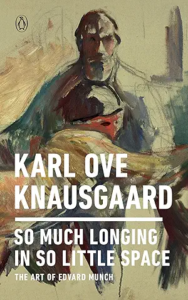So Much Longing in So Little Space: The Art of Edvard Munch by Karl Ove Knausgaard 2019
Knausgaard burst upon the literary scene between 2009 and 2011 with the publication of his six volume series “My Struggle”. Creating controversy from the beginning with its title (it translates into Mein Kampf in German), the books were long, extremely detailed, and criticized for their minutia spread over 3500 pages. Nonetheless, the series received critical acclaim, was translated into many languages, and received a number of major awards. James Wood wrote that he “remained interested even when he was bored”.
Following “My Struggle” (which I have not read), Knausgaard wrote a series of four books, his Seasons Quartet between 2015-2016, which I have read—“Winter”, “Spring”, “Summer”, and “Autumn”. They are superb ramblings stimulated by his wife’s pregnancy and then the birth of a daughter. I found them insightful and interesting.
In this extensive investigation of the work of Edvard Munch, Knausgard has turned to art criticsm, not a totally new activity since he had written about Anselm Kiefer previously. He had written a monograph on Munch which was the highlight of the catalog for the British Museum’s show on Munch in 2019, and he has expanded it into this superb book.
Munch (1863-1944) is widely acclaimed as Norway’s greatest artist and his painting, “The Scream” has been splashed all over tshirts, coffee cups, etc for years. He also seems to be of great interest to the formal art world with current exhibits in London at the National Portrait Gallery and in Cambridge, MA at the Harvard Art Museum, and just last year, there was a major exhibit of his work at the Clark in Williamstown, MA.
Knausgaard’s deep dive into Munch’s life and his work was not easy reading, but was well worth the effort as he explored the phases of Munch’s painting styles and how his personal life, one of great losses, affected his work. I found his explorations of how art is made and its importance to be fascinating. He characterizes the challenge of all art, whether painting or literature to be the difficulty between eye and page or canvas, between what we see and how we overcome the limitations of materiality to express it in words or paint. His ruminations on time were wonderful: “We cannot escape time it is a fundamental condition of our existence, and we are therefore excluded freom timelessness–it doesn’t exist for us….All works of art open up such spaces, they knock down a wall where we are standing and cause another reality to emerge…What we see is a moment in time, the moment when a particular artist applied particular brushstrokes of paint in a particular room. Everything else has changed and disappeared with time, but not the painting….Art works with the living, it attemps to grasp life in time, as it is in precisely this moment and when it succeeds, life in time becomes timeless.” “Art resembles myth in the sense that it gives individual people and single events the same exceptional weight, and in a similar way places them in a space beyond time.”
Knausgaard interviewed scholars, artists, and a film director about Munch’s work and how it had affected them, and he incuded transcripts of those conversations in the book. As one example, the great German artist, Anselm Kiefer said, “Munch painted his personal traumas in a symbolistic expressionism where the outer was only there to give form to or illustrate the inner, and where the historical or the social was almost entirely absent.” Others tried to understand how Munch had gotten so much emotion into paintings that are so stark.
The bottom line for me is that Knausgaard has provided a detailed and thouhgt-provoking analysis of Munch’s life, his art, and his impact on painting. I, for one, will go to the National Portrait Gallery next week with a better informed brain and perhaps a better attuned eye. Worth reading for any art lover or Norwegian.



